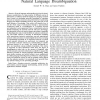Free Online Productivity Tools
i2Speak
i2Symbol
i2OCR
iTex2Img
iWeb2Print
iWeb2Shot
i2Type
iPdf2Split
iPdf2Merge
i2Bopomofo
i2Arabic
i2Style
i2Image
i2PDF
iLatex2Rtf
Sci2ools
TNN
1998
1998
Symbolic connectionism in natural language disambiguation
Abstract—Natural language understanding involves the simultaneous consideration of a large number of different sources of information. Traditional methods employed in language analysis have focused on developing powerful formalisms to represent syntactic or semantic structures along with rules for transforming language into these formalisms. However, they make use of only small subsets of knowledge. This article will describe how to use the whole range of information through a neurosymbolic architecture which is a hybridization of a symbolic network and subsymbol vectors generated from a connectionist network. Besides initializing the symbolic network with prior knowledge, the subsymbol vectors are used to enhance the system’s capability in disambiguation and provide flexibility in sentence understanding. The model captures a diversity of information including word associations, syntactic restrictions, case-role expectations, semantic rules and context. It attains highly interacti...
| Added | 23 Dec 2010 |
| Updated | 23 Dec 2010 |
| Type | Journal |
| Year | 1998 |
| Where | TNN |
| Authors | Samuel W. K. Chan, James Franklin |
Comments (0)

